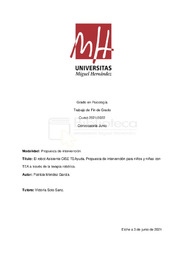Por favor, use este identificador para citar o enlazar este ítem:
https://hdl.handle.net/11000/27920Registro completo de metadatos
| Campo DC | Valor | Lengua/Idioma |
|---|---|---|
| dc.contributor.advisor | Soto Sanz, Victoria | - |
| dc.contributor.author | Méndez García, Patricia | - |
| dc.contributor.other | Departamentos de la UMH::Psicología de la Salud | es_ES |
| dc.date.accessioned | 2022-10-18T12:32:50Z | - |
| dc.date.available | 2022-10-18T12:32:50Z | - |
| dc.date.created | 2022-06 | - |
| dc.identifier.uri | https://hdl.handle.net/11000/27920 | - |
| dc.description.abstract | Los/as niños/as con Trastorno del Espectro Autista suelen presentar déficits en áreas específicas a lo largo de todo el ciclo vital, cada uno con distintos grados de afectación, adaptación funcional y funcionamiento, por lo que los/as terapeutas tienen que adaptar la intervención según las necesidades de la persona. Por ello, existen distintos abordajes de tratamiento. Recientemente ha surgido la terapia con robots sociales para tratar a esta población, mediante la combinación del enfoque psicológico y los avances en ingeniería y robótica. Esta terapia presenta una serie de ventajas frente a las terapias tradicionales, ya que las interacciones con robots tienen una complejidad menor que las interacciones humanas, lo que lleva a la mejora de la capacidad y eficiencia de las intervenciones. Es por ello, y debido al crecimiento de la incidencia y la prevalencia del trastorno, por lo que se ha decidido realizar un programa de intervención mediante la terapia robótica para niños/as entre 6 y 11 años, en el que se abordarán distintas áreas que se encuentran afectadas, con el objetivo de mejorar su calidad de vida y bienestar. Por tanto, a través del trabajo grupal, se prevé una mejora en las diferentes áreas propuestas. | es_ES |
| dc.description.abstract | Children with Autism Spectrum Disorder usually have deficiencies in specific areas throughout the life cycle, each one with different degrees of affectation, functional adaptation, and functioning. Therefore, therapists must adapt the intervention depending on the person’s necessities. Thereby, there are different treatment approaches. Social robot therapy has recently emerged to treat this population, which involves the combination of the psychological approach and the advances in engineering and robotics. This therapy presents several advantages compared to the traditional therapies, since interactions with robots are less complex than human ones, which leads to an improvement in the intervention’s capacity and efficiency. That is why, and due to the growth in the incidence and the prevalence of the disorder, it has been decided to carry out an intervention program using the robotic therapy for children between 6 and 11 years of age, in which different affected areas will be tackled, with the purpose of improving their quality of life and well-being. Therefore, through group work, an improvement in the different proposed areas is expected. | es_ES |
| dc.format | application/pdf | es_ES |
| dc.format.extent | 63 | es_ES |
| dc.language.iso | spa | es_ES |
| dc.publisher | Universidad Miguel Hernández de Elche | es_ES |
| dc.rights | info:eu-repo/semantics/openAccess | es_ES |
| dc.rights | Attribution-NonCommercial-NoDerivatives 4.0 Internacional | * |
| dc.rights.uri | http://creativecommons.org/licenses/by-nc-nd/4.0/ | * |
| dc.subject | trastorno del espectro autista (TEA) | es_ES |
| dc.subject | terapia róbotica | es_ES |
| dc.subject | niños/as | es_ES |
| dc.subject | intervención | es_ES |
| dc.subject | atención temprana | es_ES |
| dc.subject | autism spectrum disorder (ASD) | es_ES |
| dc.subject | robotic therapy | es_ES |
| dc.subject | children | es_ES |
| dc.subject | intervention | es_ES |
| dc.subject | early assistance | es_ES |
| dc.subject.other | CDU::1 - Filosofía y psicología::159.9 - Psicología | es_ES |
| dc.title | El robot asistente CISE TEAyuda. Propuesta de intervención para niños y niñas con TEA a través de la terapia robótica | es_ES |
| dc.type | info:eu-repo/semantics/bachelorThesis | es_ES |

Ver/Abrir:
TFG-Méndez García, Patricia.pdf
3,22 MB
Adobe PDF
Compartir:
 La licencia se describe como: Atribución-NonComercial-NoDerivada 4.0 Internacional.
La licencia se describe como: Atribución-NonComercial-NoDerivada 4.0 Internacional.
Herramientas de Administrador
.png)